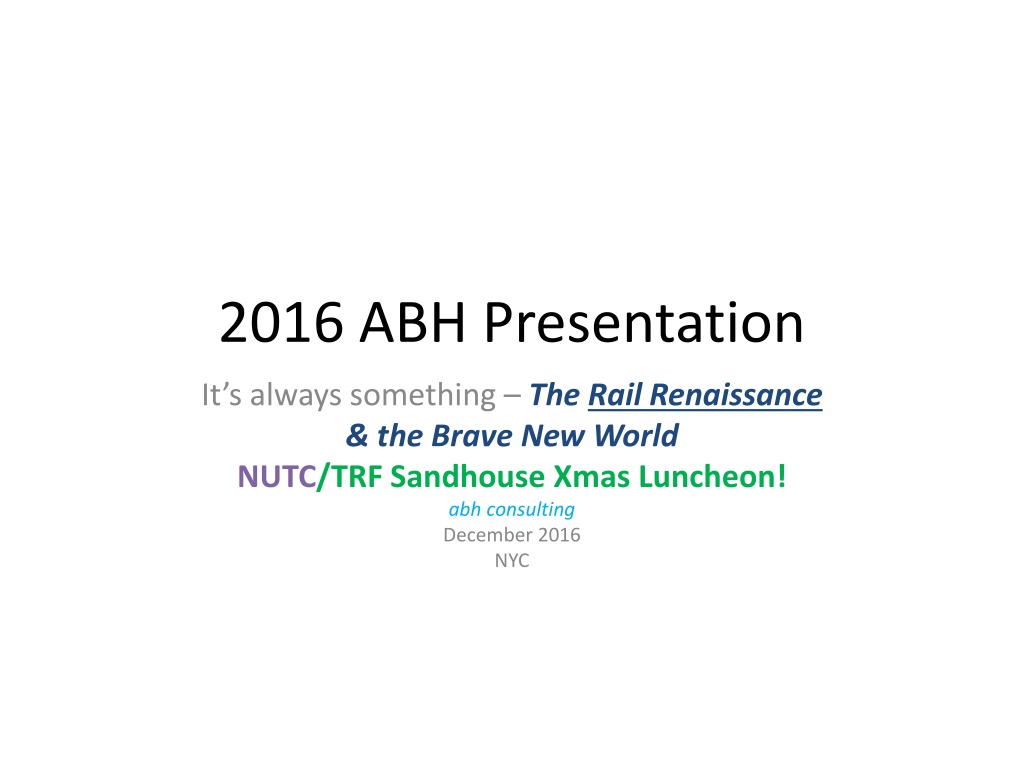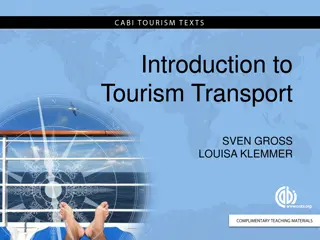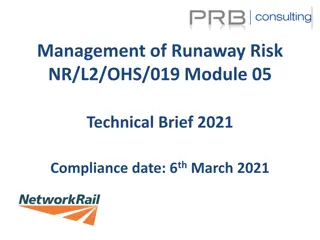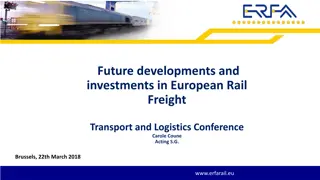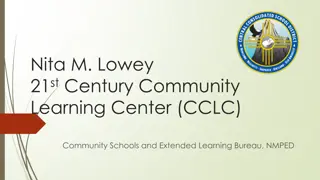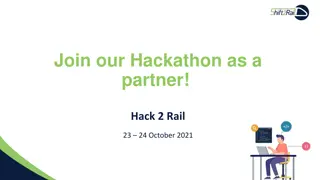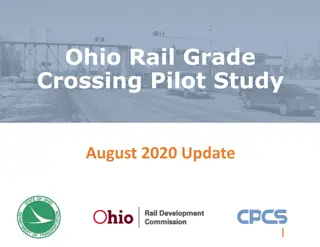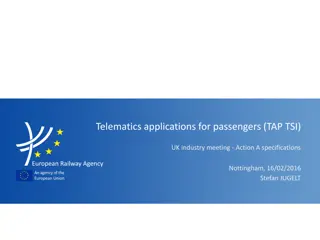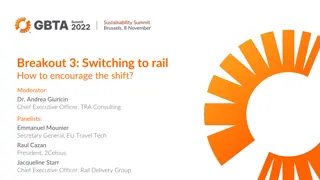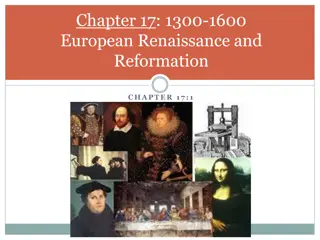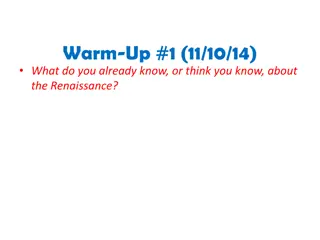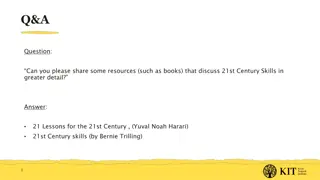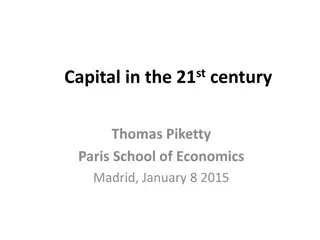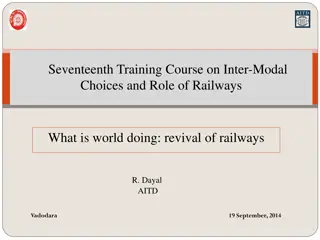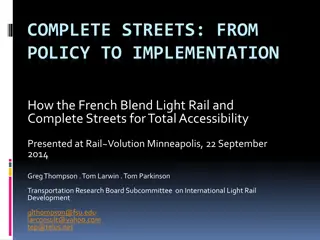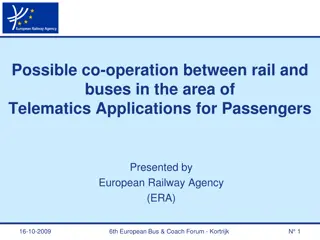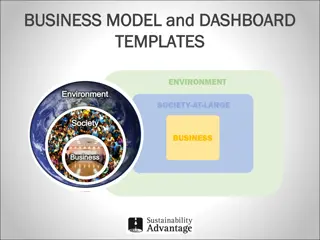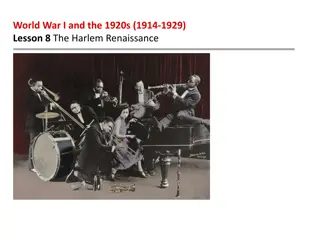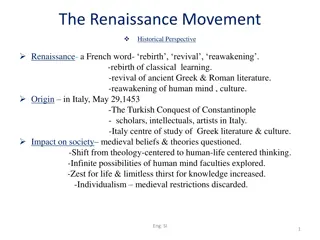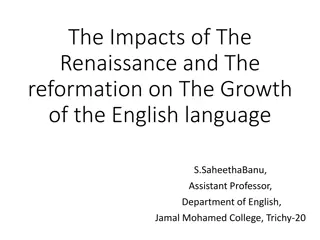The Rail Renaissance & Brave New World in the 21st Century
Diving into the rail industry's evolution through deregulation and vertical integration, the document explores the performance of U.S. freight railroads post-Staggers Act, challenges faced, and potential promises under the new administration. It shines a light on the changing landscape of the railroad industry, touching on factors like globalization, infrastructure, energy impact, and the intersection of government policy and financial sentiments.
Uploaded on Sep 24, 2024 | 0 Views
Download Presentation

Please find below an Image/Link to download the presentation.
The content on the website is provided AS IS for your information and personal use only. It may not be sold, licensed, or shared on other websites without obtaining consent from the author. Download presentation by click this link. If you encounter any issues during the download, it is possible that the publisher has removed the file from their server.
E N D
Presentation Transcript
2016 ABH Presentation It s always something The Rail Renaissance & the Brave New World NUTC/TRF Sandhouse Xmas Luncheon! abh consulting December 2016 NYC
Deregulation & Vertical Integration Works! U.S. Freight Railroad Performance Since Staggers (1981 = 100) 300 275 250 Productivity 225 200 Volume 175 Staggers Act passed Oct. 1980 150 125 100 Revenue 75 50 Rates 25 0 '64 '67 '70 '73 '76 '79 '82 '85 '88 '91 '94 '97 '00 '03 '06 '09 '12 '15 "Rates" is inflation-adjusted revenue per ton-mile. "Volume" is ton-miles. "Productivity" is revenue ton-miles per constant dollar operating expense. The decline in productivity in recent years is largely due to the effect of higher fuel prices in the productivity calculation. Source: AAR
21stCentury: the Railroad (equity) Renaissance: From Triumph to Challenged Rails have well beaten the stock market 2001-2014 7 Big Reasons Globalization/trade (IM) Capex&Productivity&Service Pricing & ROI Through economic turmoil (manufacturing/energy/markets) Of Late Not So Much (now regaining par ) Energy Impact: real (coal) and hype (CBR) Visibility & Sentiment change financial & government/public Earnings Power (always) misunderstood: Rails beat Street estimates in the Boom, in the great Recession, and the tepid recovery, in this period 2015: Record margins & results (and Capex and Buybacks/DPS and .) despite the coal - and drought and lukewarm economy, etc . Rails are still re-gaining market share from the highway despite oil prices (2017?) Brave New World
The World Turned Upside Down Looking back, who forecasted this? In a world with no base assumptions, how does one plan? Regional Bitterness to ensue Some commodities will be winners (barley, oats) Some Losers (goats) Oh! The humanity!!
New Administration Promises 1. The end of the War on Coal 2. Drill, Baby, Drill (and pipelines, eh!) 3. Infrastructure (Privately Financed) 4. Bye-bye Trade (NAFTA) 5. Get out and stay out! End of the 150-year relationship of GOP & Big Business (ask Ford) 6. War on Regulation (maybe) on Red tape (likely) 7. Lower taxes 8. Labor Who s driverless, now?
Overview of North American Rail Environment & Key Issues Rail Renaissance (and heavy Capex!)is the theme (1980-) 2001-2013; OVER?? Major Challenges Emerge Energy Decline (Coal/Oil) End of the Commodity Super Cycle (?); Trade Slowdown; $/FX Service & Safety Issues; Rereg threats re-emerge Service & Productivity & Safety (all related to Capex) are a) getting resolved & b) Even More Important Than Ever . Managements, New & Challenged: Visibility, Guidance; Capex & Cash Asked & Answered: Is M&A the Solution? (What s the problem?) What now? Intermodal performance more critical than ever (recently confusing) Rails, however, are still re-gaining market share from the highway 6
Close Correlation Between RR ROI and Reinvestments 14% $30 13% $28 RR ROI** (left scale) 12% $26 11% $24 10% $22 9% $20 Reinvestments* (right scale, $ bil) 8% $18 7% $16 '05 '06 '07 '08 '09 '10 '11 '12 '13 '14 *Capital spending + maintenance expense. **Net railway operating income / average net investment in transportation property. Data are for Class I railroads. Source: AAR 16
Class I Freight Railroad Capital Spending ($ billions) $18 $16 $14 $12 $10 $8 $6 $4 $2 $0 '80 '83 '85 '87 '89 '91 '93 '95 '97 '99 '01 '03 '05 '07 '09 '11 '13 '15 Source: AAR 8
Returns Finally Justify the Massive Expenditures But Do Future Prospects?? 9
Railroads Help Keep Coal- Based Electricity Lumber & wood products: 7,095 (2.1%) Rail Carloads: 2015 vs. 2014 Change in U.S. + Canadian Motor vehicles & parts: 40,656 (3.6%) All other carloads: 28,133 (9.4%) Chemicals: 10,704 (0.5%) Grain mill products: 4,436 (0.8%) Farm products excl. grain: 1,360 (0.6%) Coke: 1,027 (0.5%) Note: intermodal is not included in this chart. Intermodal was up 364,192 units (2.2%) in 2015 over 2014. Food products: 480 (0.1%) Primary forest products: -682 (-0.4%) Source: AAR Weekly Railroad Waste & nonferrous scrap: -7,870 (-4.1%) Pulp & paper products: -10,883 (-2.3%) Nonmetallic minerals: -20,710 (-6.3%) Coal: -755,916 (-12.0%) Grain: -25,526 (-1.6%) Stone, clay & glass prod.: -32,131 (-6.6%) Metallic ores: -182,607 (-18.5%) Crushed stone, gravel, sand: -39,766 (-2.9%) Iron & steel scrap: -47,095 (-17.7%) Petrol. & petr. products: -73,056 (-6.1%) Primary metal products: -93,070 (-13.8%) SLIDE 10 ASSOCIATION OF AMERICAN RAILROADS
Shale-Related Rail Traffic Relative to Coal Loadings U.S. Quarterly Carloads Originated 1,800,000 1,600,000 4 Qtr. Avg. 1,754,908 STCC 14413 - Industrial sand and gravel (includes frac sand) 1,400,000 -365,073 1,200,000 3 Qtr. Avg. 1,389,835 STCC 131 - Crude Petroleum and Natural Gas 1,000,000 800,000 +127,134 600,000 STCC 1121 - Bituminous coal 4 Qtr. Avg. 204,778 400,000 4 Qtr. Avg. 77,644 200,000 0 Source: Surface Transportation Board, PLG Analysis March 2016
New Energy Rail Growth Story Crude & Frac Sand 160,000 Crude industrial sand (STCC 14413) Crude oil (STCC 131) 140,000 120,000 100,000 80,000 60,000 40,000 20,000 0 2010 2011 2012 2013 2014 2015 2016 Source: AAR (Freight Commodity Statistics)
Silver Linings? Service (& Safety) Recovery Trend (Capex Pays Off) Productivity (& volume?) Inflection Restoration of the Grand Bargain Reduced (N/T) Political Pressure Coal stabilization (Part Two)?? IM (etc.) latent demand .Bi-Modal results; Ag Gas-fired Industrial Buildout; Southbound migration of industry Revised MoW Capex (GTMs/Mix) frees CF/2017+
The Grand Bargain In return for higher prices (& ROI), rails spend, increase capacity & improve service (2005-2012) The unstated Grand Bargain Rails gain pricing power (~2003) & F/S Rails (re) Gain Market Share Rails Spend Cash Disproportionately on Capex (~18-20% of revenues) Promotes Virtuous Circle all stakeholders benefit Under challenge, perceived and real
Future Growth Potential (Revised) Secular stories and specific targeted sectors(in order) . 1. Intermodal international and now domestic 2. Chemicals/re-industrialization? Near-sourcing/Mexico 3. Cyclical recovery housing, steel, autos 4. Grain & Food Exports up 10% this CY? NA still the world s breadbasket, but obviously (un)predictable? 5. Car-load merchandise capacity available! 6. Shale/oil/sand demonstrated flexibility 7. Other rail opportunities exist but in smaller scale: for ex: The manifest/carload problem - Unitization - Industrial Products/MSW - Perishables
Issues for RR & Intermodal 2017-21 Return to Growth? Fight over Capital MoW vs Buybacks? M&A Fight fallout effect on Capex? RR Pricing Power Still? Factors: Oil Prices, Consumer Spend/GDP, Truck Capacity Infrastructure Advantage (vs subsidized highway) Trade and the Panama Canal impacts? NAFTA? Rail Service (& Safety) Improvements Coal stabilization Driverless beats One Man Crews to the market? 18
Railroad Respond to the Challenges Traditional Response cost cutting Strategic response to secular changes coal Capex response TBD (stakeholder division?) Radical change (ex. M&A)? (Continue to) Focus on growth areas Retain concentration on Service & Productivity Innovate! ( regain tech mojo )
Class I Railroad Employment 176,000 172,000 168,000 164,000 160,000 156,000 152,000 148,000 144,000 140,000 2008 2009 2010 2011 2012 2013 2014 2015 2016 Source: STB SLIDE 20 SLIDE 20 ASSOCIATION OF AMERICAN RAILROADS
Railroad Philosophy Critical to the RR Renaissance has been Capex Private vs public capital (failing US infrastructure) Capex sparked by growth and ROI prospects examples: IM, CBR Open Access antithetical to this .right? Is a RR its Network (Class One belief) OR is it its Operators (Hunter)?? Cult of the OR vs ROIC; short-termism
2016+ Capex Most Important Decision Period in Years Capex down across the board (annopunced average -16%!) except CN! Further cuts (NS, UP) and hints (CN) during the year (FY -20%?) Coal: Stranded Assets ? NS selling segments .CSX of Tomorrow Coal/Mix: Reduced Gross Ton Miles=Reduced Maintenance of Way? Yet remember: Service & Safety are even more critical to future RR success Changing mix of capex? Changing %revenues (16%)? PTC Extension resolution more to develop? ECP? 23
Railroads: Far More Capital Intensive Than Other Industries Capital Expenditures as a % of Revenue: 2014 20% 18% Class I RRs 16% 14% 12% 10% 8% Nonmetallic Minerals Computers Wood Prod. Motor Vehicles 6% 4% Food 2% 0% RRs Paper Plastics & Rubber Chemicals All Mfrg. Petr. & Coal Prod. Sources: Census Bureau, AAR ASSOCIATION OF AMERICAN RAILROADS SLIDE 24
Railroads Help Keep Coal- Based Electricity Railroads Are Far More Capital Intensive Than Most Other Industries Computer & electr. products Capital Spending as % of Revenue* Average all manufacturing Food Petroleum & coal products Machinery Chemicals Wood producs Primary metal products Fabricated metal products Motor vehicles & parts Plastics & rubber products Paper Nonmetallic minerals 3% 2% 2% 3% 3% 3% 3% 3% 3% 3% 4% 5% 5% Class I Railroads 18% *Avg. 2005-2014 Source: Census Bureau, AAR SLIDE 25 ASSOCIATION OF AMERICAN RAILROADS
Maintenance Spending Remains Durable Select Class I CapexBudgets $ in Billions $5.0 $4.3 $3.7 4.0 (18%) $2.9 $2.8 $2.4 3.0 $2.5 $1.9 $2.4 +4% (10%) $1.4 $1.4 2.0 $1.3 $1.2 +2% (1%) +7% 1.0 $1.9 $1.8 $1.5 $1.4 $1.2 $1.2 0.0 2015 2016B 2015 2016B 2015 2016B Infrastructure Other Capex Note: CN in CAD. SOURCE: Greenbriar!
Railway Night Sweats Politics (& Regulation) Trade Globalization over? (Specifically) NAFTA which impacts S .&N! Driverless AV beer runs! (ahh the irony) Amazon who isn t scared? 3-D Printing good enough for combat? Short-Termism/Over-reactions Capex and FCF planning
Take-Aways From RailTrends16 Good: IM & (especially) Merchandise Opportunities and near-term inflection; plastics, Ag, Maybe Good: reduced taxes and regulation? Infrastructure? Bad: Railcar production, coal (war is over) Ugly: Visibility, Trade Really, really ugly? AV trucking Have Faith & Innovate: Canadian National
Competitive Advantage: RR Capex vs Aged National Infrastructure
ABH Consulting/www.abhatchconsulting.com Anthony B. Hatch 1230 Park Avenue New York, NY 10128 (917) 520-7101 ABH18@mindspring.com www.railtrends.com
